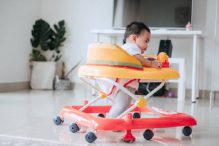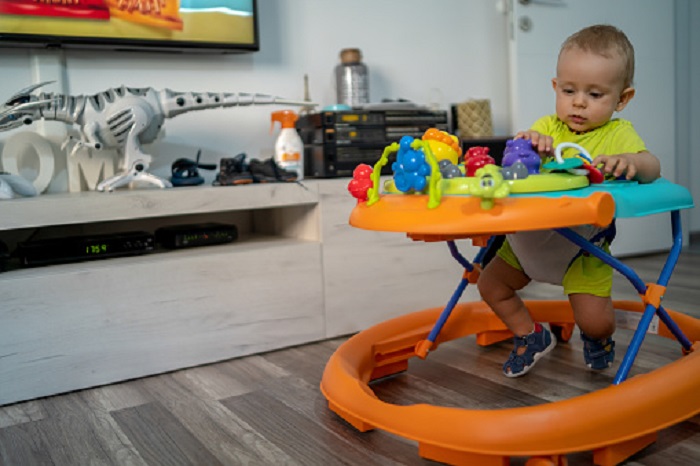Can the walker help the child who begins to stand up? Generally speaking, no. On the contrary, it is potentially harmful. But if continued use is not recommended, the walker could be useful for a certain period for slightly chubby children who and therefore are more “lazy” than their peers. For safety, you can use the wood baby walker.
Much appreciated by children, who enjoy the freedom of being able to move around the house, less by specialists, who emphasize that if the walker can be of help for slightly lazy or chubby children who are late in taking their first steps, it continued use could hinder the correct psychomotor development.
The limits of the walker
By the time they are 10-12 months old, most babies begin to stand and take their first steps. But it is not a general rule for everyone because the development times are individual and so if there are more precocious children who start even at 8-9 months, others wait comfortably for a year and a half.
Can the walker give a ‘little help’? In general, no, on the contrary, it is potentially harmful, because it makes you set the gait badly, moreover it does not allow the child to train the muscles and the sense of balance. Furthermore, unlike what is generally believed, it does not favor the possibility of walking earlier but, on the contrary, it can be an obstacle to correct psychomotor development.
Furthermore, it can be an impediment to the development of the ability to ‘fall well,’ which, when the child learns to walk, is very important in order not to get hurt. In addition, it can prevent him from acquiring the perception of his own motor limits.
Finally, it has been noted that the child accustomed to the walker tends to walk on tiptoe more often, to the disadvantage of the ability to maintain balance in an upright position “.
The walker is useful for lazy children
If continued use is not recommended, the walker could be useful for a certain period for slightly chubby children, who have greater muscle hypotonia (not linked to pathologies) and are therefore more “lazy” than their peers.
In this case, the walker offers support that makes the child safer and more stable and allows a good workout to his muscles, so that they acquire the necessary tone to support him in an upright position.
To use the walker correctly, however, it is essential to adjust the height of the panty so that not only the tip of the footrests on the ground but the whole sole and heel. And, of course, make sure that the baby does not encounter any dangers along its path!
The walker
Generally, the walker is used in the phase in which the baby is not yet able to walk alone but is able to sit up, therefore around 6 months. Many mothers buy it for their children, but this choice, over the years, has been the subject of discussion. Following the European standards, the structure of the walker seems to be safe: it does not tip over, the materials are non-toxic, it has an anti-shock structure, the seat is padded, it has a safety system that stops the walker when it is not more on a surface (for example if you are on a step); moreover, the panty, where the child is seated, is soft but resistant (in fabric or plastic). The common belief is that this tool helps the little ones to take their first steps. In fact, some studies support the hypothesis that,
Furthermore, from a strictly psychomotor point of view, not experiencing frequent falls and having to face the “dangers” of walking does not create a sense of balance in him, does not allow him to explore the world around him; not to mention that the child tends to assume a wrong posture, walking on tiptoe.
In the past, in Canada, the production, sale (including second-hand) and advertising of baby walkers were banned. The Canadian minister of health established that this accessory could be very dangerous for the child, as it causes many domestic accidents. In fact, it would give the child the possibility to access stairs or uneven surfaces and to grab potentially dangerous objects. Then, however, the pressing demand on the market by mothers did not make the ban practicable.
What is certain is that the walker makes life a little easier for the mothers who use it. If they are busy in the kitchen, talking on the phone, doing the washing machine or hanging out the laundry, the walker allows you not to have to hold the baby in your arms for a while. And the children enjoy it a lot.
The most neutral advice that can be given is to use it in moderation, to avoid the “side effects,” and to follow some precautions to limit the risks:
Never leave the child alone, move potentially dangerous objects out of his reach, as well as possible obstacles for the wheels, choose walkers that do not work with a snap system (to prevent the child from injuring his hands), do not lift the walker when the baby is inside.
The walker for the baby: yes or no?
Specialists are against the walker because it does not favor the possibility of walking and can be an obstacle to the correct psychomotor development of the child.
The walker does not enjoy the approval of specialists, even if, in fact, most children appreciate the freedom to move around the house it provides. In fact and unlike what is generally believed, it does not favor the possibility of walking earlier, but, on the contrary, it can be an obstacle to correct psychomotor development. Furthermore, it can prevent the child from acquiring the perception of his own motor limits.
Finally, it has been noted that the child accustomed to the walker tends to walk on tiptoes more often, to the disadvantage of the ability to maintain balance in an upright position.


